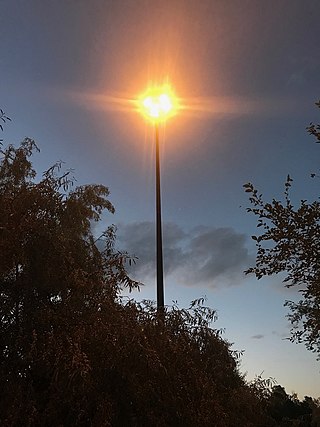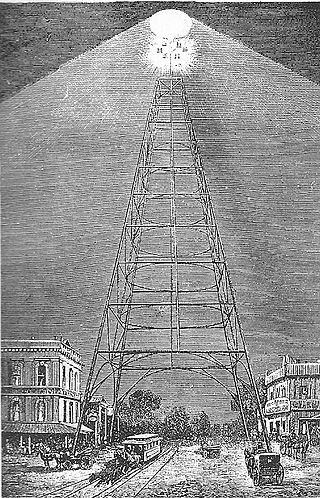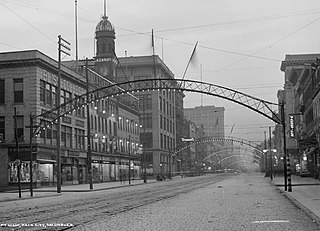
An electric light, lamp, or light bulb is an electrical component that produces light. It is the most common form of artificial lighting. Lamps usually have a base made of ceramic, metal, glass, or plastic, which secures the lamp in the socket of a light fixture, which is often called a "lamp" as well. The electrical connection to the socket may be made with a screw-thread base, two metal pins, two metal caps or a bayonet mount.

Artificial lighting technology began to be developed tens of thousands of years ago and continues to be refined in the present day.

An arc lamp or arc light is a lamp that produces light by an electric arc.

Limelight is a non-electric type of stage lighting once used in theatres and music halls, and was the first solid-state lighting device. An intense illumination is created when a flame fed by oxygen and hydrogen is directed at a cylinder of quicklime, which can be heated to 2,572 °C (4,662 °F) before melting. The light is produced by a combination of incandescence and candoluminescence. Although it has long since been replaced by electric lighting, the term has nonetheless survived, as someone in the public eye is still said to be "in the limelight". The actual lamps are called "limes", a term which has been transferred to electrical equivalents.

A sodium-vapor lamp is a gas-discharge lamp that uses sodium in an excited state to produce light at a characteristic wavelength near 589 nm.

A street light, light pole, lamp pole, lamppost, street lamp, light standard, or lamp standard is a raised source of light on the edge of a road or path. Similar lights may be found on a railway platform. When urban electric power distribution became ubiquitous in developed countries in the 20th century, lights for urban streets followed, or sometimes led.

Christmas lights are lights often used for decoration in celebration of Christmas, often on display throughout the Christmas season including Advent and Christmastide. The custom goes back to when Christmas trees were decorated with candles, which symbolized Christ being the light of the world. The Christmas trees were brought by Christians into their homes in early modern Germany.

Gas lighting is the production of artificial light from combustion of a fuel gas such as hydrogen, methane, carbon monoxide, propane, butane, acetylene, ethylene, coal gas or natural gas. The light is produced either directly by the flame, generally by using special mixes of illuminating gas to increase brightness, or indirectly with other components such as the gas mantle or the limelight, with the gas primarily functioning as a heat source for the incandescence of the gas mantle or lime.

The history of street lighting in the United States is closely linked to the urbanization of America. Artificial illumination has stimulated commercial activity at night, and has been tied to the country's economic development, including major innovations in transportation, particularly the growth in automobile use. In the two and a half centuries before LED lighting emerged as the new "gold standard", cities and towns across America relied on oil, coal gas, carbon arc, incandescent, and high-intensity gas discharge lamps for street lighting.

A light fixture, light fitting, or luminaire is an electrical lighting device containing one or more light sources, such as lamps, and all the accessory components required for its operation to provide illumination to the environment. All light fixtures have a fixture body and one or more lamps. The lamps may be in sockets for easy replacement—or, in the case of some LED fixtures, hard-wired in place.

Aviation obstruction lighting is used to enhance the visibility of structures or fixed obstacles which may conflict with the safe navigation of aircraft. Obstruction lighting is commonly installed on towers, buildings, and even fences located in areas where aircraft may be operating at low altitudes. In certain areas, some aviation regulators mandate the installation, operation, color, and/or status notification of obstruction lighting. For maximum visibility and collision-avoidance, these lighting systems commonly employ one or more high-intensity strobe or LED devices which can be seen by pilots from many miles away from the obstruction.
Brush Electric Illuminating Company was a Manhattan, New York business of the late 19th century. In April 1881 it made a bid to the New York City gas commissioners to provide lighting to the district encompassing Broadway and Fifth Avenue, from 14th to 34th Streets. It included the cross streets in between as well as Union Square and Madison Square.

Architecture of the night or nocturnal architecture, also referred to as illuminated architecture and, particularly in German, light architecture, is architecture designed to maximize the effect of night lighting, which may include lights from within the building, lights on the facade or outlining elements of it, illuminated advertising, and floodlighting.

High-mast lighting is a tall pole with lighting attached to the top pointing towards the ground, usually but not always used to light a highway or recreational field. It is used at sites that require lighting over a large area. The pole that the lighting is mounted on is generally at least 30 m (98 ft) tall, while the lighting consists of a luminaire ring surrounding the pole with one or several independent lighting fixtures mounted around it. Most units have four, six or eight lights in the ring, with three, five, ten, twelve and sixteen lights used in rarer instances. While most high-mast lights are high-pressure sodium, other types such as mercury vapor, metal halide and LED, have also been used. Some units have the lighting surrounded by a circular shield to prevent or reduce light pollution or light trespass from affecting neighborhoods adjacent to the highway. Maintenance of these systems is done by lowering the luminaire ring from the mast head to the base using a winch and motor to the ground or at a height accessible by a cherry picker and located in areas to allow for easier access without disrupting traffic.

The Zilker Holiday Tree is a 155 foot Christmas tree made from lights draped from a moonlight tower located in Zilker Park. During the Christmas season the tree is lit by over 3000 colored lights. The lighting of the tree has been an annual tradition in Austin since 1967. On December 26, 2010, a five-kilometer run named after the tree took place.

Walter D'Arcy Ryan was an influential early lighting engineer who worked for General Electric as director of its Illuminating Engineering Laboratory. He pioneered skyscraper illumination, designed the Scintillator colored searchlights display, and was responsible for the lighting of the Panama–Pacific International Exposition in San Francisco and the Century of Progress Exposition in Chicago, in addition to the first complete illumination of Niagara Falls. He combined illumination into both an art and a science.
A light tower is a piece of mobile equipment which has one or more high-intensity electric lamps and a mast. Almost always, the lights are attached to the mast, which is attached to a trailer, with a generator set to power the lamps. Normally the lamps are metal halide bulbs and the generator is powered by a diesel engine. However, battery-powered, solar-powered and hydrogen-powered sets are available; light towers with electrodeless lamps lighting are also sold. Modular kits permit separation of the generator set, trailer, lights and mast from each other. Another variation is an inflatable mast. Particularly when an inflatable mast is used, the lights may be placed close to the ground, with a reflector attached to the mast. When soft lighting is wanted, an inflatable "balloon" diffuser may be used. An inflatable mast may serve as a diffuser.

The moonlight towers in Austin, Texas, are the only known surviving moonlight towers in the world. They are 165 feet (50 m) tall and have a 15-foot (4.6 m) foundation. A single tower casts light from six carbon arc lamps, illuminating a 1,500-foot-radius (460 m) circle brightly enough to read a watch.

The San Jose electric light tower, also known as Owen's Electric Tower after its creator and chief booster, was constructed in 1881 at an intersection in downtown San Jose, California, as a "high light" or moonlight tower to light the city using arc lights. A pioneer use of electricity for municipal lighting, it was later strung with incandescent bulbs and was destroyed in a storm in December 1915. A half-size replica stands at History Park at Kelley Park.

Columbus, Ohio has a legacy of using wooden and metal arches on its urban streets. Initially installed in 1888 for lighting during a national Grand Army of the Republic convention, the arches or more permanent replacements were placed on city streets until around 1914, used as overhead lines for electric streetcar wires, until more conventional poles became more favorable. Modern-day arches were installed in the city's Short North neighborhood in 2002, in an effort to unify the district, draw visitors, and increase business sales.





















